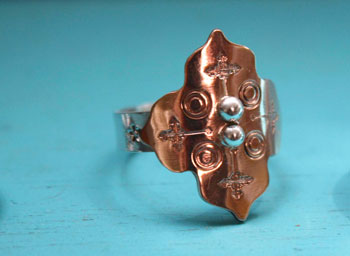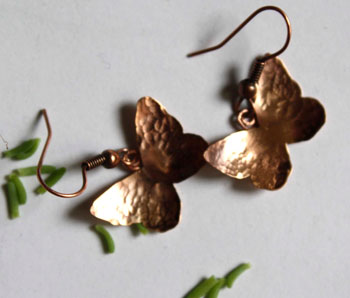- Jewelry
- Inspiration
- Good Deals
- Paintings
- About
- Contact
JEWELRY
- Anklet
- Bracelets
- Brooches
- Cufflinks
- Earrings
- Pendants & Necklaces
- Rings
- Draw your jewelry
- GOOD DEALS
- How to clean your jewel
- Metal we used
INSPIRATION
- Our imagination
- Birthstones
- Druids and druidesses
- Flower meanings
- History, archeology jewelry
- Japanese symbols
- Lithotherapy and stone choice
- Illumination jewelry
- Maya calendar jewelry
- Stone color symbolism
- Stones Catalogue
- Searches a theme on the site
ABOUT
Copper: history, healing properties and lithotherapy

Copper properties

Copper, a naturally abundant metal in the Earth's crust, has a distinctive salmon-pink hue on a freshly cut surface, earning it the nickname "red metal." Its color gradually changes with oxidation, forming a greenish patina called "verdigris," which naturally protects the metal from corrosion.
Its name comes from the island of Cyprus, one of the first regions to exploit copper mines in antiquity. The Romans called it "aes cyprium" (metal from Cyprus), a name that eventually simplified to "cuprum," giving rise to the modern English term "copper."
Copper boasts numerous remarkable physical properties. It is highly resistant to corrosion, making it an ideal choice for manufacturing tools and structures. Its malleability allows it to be easily shaped, whether into wires or sheets. One of its most sought-after characteristics is its exceptional thermal and electrical conductivity, second only to silver, making it a preferred material for energy transmission systems.
As an essential trace element, copper also plays a crucial biological role in the human body. It aids in the production of red blood cells, the maintenance of bone health, and immune system function. The alloying of copper with other metals, notably zinc (to form brass) or tin (to produce bronze), has allowed for the development of materials with varied and versatile properties, widely used since the Bronze Age.
History, legends and beliefs about copper
Copper was one of the first metals used by humanity, marking a crucial stage in its development. Its significance was such that an entire historical period was named the "Copper Age," which later evolved into the "Bronze Age" with the introduction of metal alloys.
The Copper Age began at different times across various regions of the world. The earliest traces were discovered in Iran, at the archaeological site of Sialk III, dating back to the 5th millennium BCE, while copper objects have also been found in Anatolia as early as 6000 BCE.
The use of the lost-wax casting technique in Asia dates back to 4500-4000 BCE, while in China, the earliest evidence of copper work dates to around 2800 BCE. In the Andes, copper metallurgy has been documented since 2000 BCE, and in West Africa, it likely began around 900 BCE. In Central America, copper working is more recent, dating to around 600 CE.
In Europe, the Copper Age is generally placed between 3200 and 2000 BCE. The discovery of Ötzi, a hunter dating back to around 3300 BCE, who was found with a copper axe, is evidence of the metalworking skills of that era.
Similarly, the Bronze Age is marked by the use of copper alloys with other metals, particularly zinc to produce brass, or tin to make bronze.

The Egyptians seem to have made bronze objects as early as 3500 BCE. By 2400 BCE, they were using copper to sterilize wounds and water. Around 1500 BCE, copper was also used to treat headaches, burns, and itching. The hieroglyphic symbol for copper is the Ankh, representing eternal life.
In Egypt, copper played a central role in many aspects of daily and spiritual life. The Egyptians attributed sacred and divine properties to copper, especially for protecting souls in the afterlife. Copper objects were often placed in tombs to accompany the deceased on their journey after death. In medicine, copper was used to heal open wounds and disinfect water. The Ebers Papyrus, one of the oldest medical texts, mentions copper-based preparations for treating various ailments.
Bronze artifacts have been found in Sumerian cities, dating back to 3000 BCE, demonstrating the early spread of this advanced metallurgical technology.
In Europe, the Bronze Age reached its peak between 2500 and 600 BCE, while brass became particularly important under the Roman Empire.
In the Mediterranean region, copper exploitation was mainly centered around the island of Cyprus during Antiquity. The earliest copper mines enabled the Minoan, Mycenaean, and Phoenician civilizations to thrive by organizing the trade of this precious metal.
In ancient Greece, the metal was known as "Chalkos" and was associated with the goddess of beauty, Aphrodite (Venus for the Romans), due to its luster and origin from Cyprus, the island dedicated to the goddess. The Greeks used copper mirrors and considered the metal as linked to seduction and youth. Hippocrates recommended the use of copper to treat varicose ulcers on the legs as early as 400 BCE.
The Romans adopted this tradition and named the metal "Aes Cyprium" or "metal of Cyprus," a term later simplified to "cuprum," which gave rise to the word "copper" in English. The Romans also used copper as currency between the 6th and 3rd centuries BCE, while developing the largest copper production of the time, extracted from Hispania, Cyprus, and Central Europe. This industrial dominance was only surpassed during the Industrial Revolution.
According to the Bible, the doors of the Temple of Jerusalem were made of Corinthian bronze, a prestigious alloy. In Solomon's Temple, there was also the "Brazen Sea" or "Sea of Bronze," an immense circular reservoir capable of holding 45 tons of water, resting on twelve bronze sculptures of oxen, representing the twelve tribes of Israel.
Another intriguing copper artifact is the Copper Scroll of the Dead Sea, discovered at Khirbet Qumran. Unlike the other Dead Sea Scrolls, written on leather or papyrus, this one is made of almost pure copper. It mentions a treasure, supposedly from the Second Temple of Jerusalem, though the exact location of this treasure remains to be formally identified.

In ancient India, well before 1000 BCE, copper was celebrated for its medicinal virtues, forming an integral part of Ayurvedic holistic medicine. Considered a sacred metal, copper was used for its healing and energizing properties, embodying the deep connection between humanity and nature in the quest for well-being and healing.
In Baghdad, in 1936, an extraordinary discovery was made: a copper object dating back to around 248 BCE. Copper cylinders soldered with lead, inserted into a ceramic vessel about fifteen centimeters high, were found. Some speculate that this might be the first battery in human history, though this fascinating theory has yet to be confirmed. This historical enigma continues to intrigue researchers and spark passionate debates about ancient technological advancements.
Across the Atlantic, the Aztecs used copper as a remedy for sore throats, practicing gargling to relieve pain and discomfort.
After Antiquity, although copper’s importance declined with the rise of ironwork, it continued to play a key role in the arts and sciences.
During the Renaissance, copper regained prominence in sculpture and was also widely used to sheathe the hulls of ships, such as those of Christopher Columbus. Its use extended to bell-making, with its ability to modify sound being particularly valued.
From the 19th century onwards, copper became a metal of primary importance once again, especially in the electrical industry for wiring. Today, it is the third most used metal in the world, after iron and aluminum, and finds applications in sectors such as plumbing and superconductors.
In popular culture, copper is much more than just a metal. It is often associated with the planet Venus, embodying qualities of femininity, youth, and love. Its warm hue and luster evoke passion and vitality, making copper a powerful symbol of feminine energy and romance.
In folklore traditions, copper is also celebrated as the symbol of 32 years of marriage. This longevity pays tribute to the durability and strength of the marital bond, just like copper’s malleable yet resilient nature.
In alchemy, copper holds deep significance. It is represented by a stylized mirror, a symbol of both the planet Venus and the reflective properties of the metal itself. This alchemical mirror represents copper’s ability to reveal inner truths and illuminate hidden aspects of the soul, symbolizing the pursuit of knowledge and personal transformation. Alchemists believed that copper could transmute negative energies into positive forces, further enhancing its spiritual and mystical role.
Mines: Chili, the USA, Peru, Australia, Russia, Indonesia, Canada, Zambia, Poland.
Healing properties and benefits of copper
Copper, a metal with remarkable properties, offers a wide range of benefits for health and well-being:
- By promoting balanced blood flow and supporting the proper functioning of the circulatory system, copper helps maintain optimal blood circulation, essential for overall health. It also plays a role in the production of red blood cells and supports tissue oxygenation, thereby improving vitality and physical endurance.
- Its use in treating bone issues highlights its regenerative virtues. Copper plays a crucial role in collagen formation, a key element for the strength and flexibility of bones and joints. It also helps prevent diseases like osteoporosis by strengthening bone structures.
- Renowned for its anti-inflammatory properties, copper is a valuable ally in relieving arthritis and rheumatism. It helps reduce joint inflammation, thus easing pain and improving mobility. Some traditions also associate wearing copper bracelets with better management of chronic pain related to these conditions.
- Recommended for regulating sexuality, copper plays a role in hormonal balance and sexual well-being, particularly by promoting the synthesis of certain key hormones. It helps combat hormonal imbalances, contributing to a fulfilling intimate life.
- Its ability to fight inflammation, envenomation, and intoxication makes it a powerful natural remedy. Thanks to its antibacterial properties, it offers protection against various ailments and toxins. In antiquity, Egyptians and Greeks used copper tools to disinfect water and heal wounds, illustrating its capacity to prevent infections.
- Copper is also known for its ability to protect vital organs such as the kidneys, spleen, and gallbladder. It helps regulate metabolic functions, strengthens the immune system, and prevents premature cellular aging. Through its action on the body's purification systems, it promotes the elimination of toxins and supports long-term optimal health.
⚠ Please note that all healing properties presented for gemstones are gathered from various sources. This information is provided as a service and is not intended to treat medical conditions. It is recommended to consult a healthcare professional for serious medical issues and not to rely solely on gemstones as a treatment.







